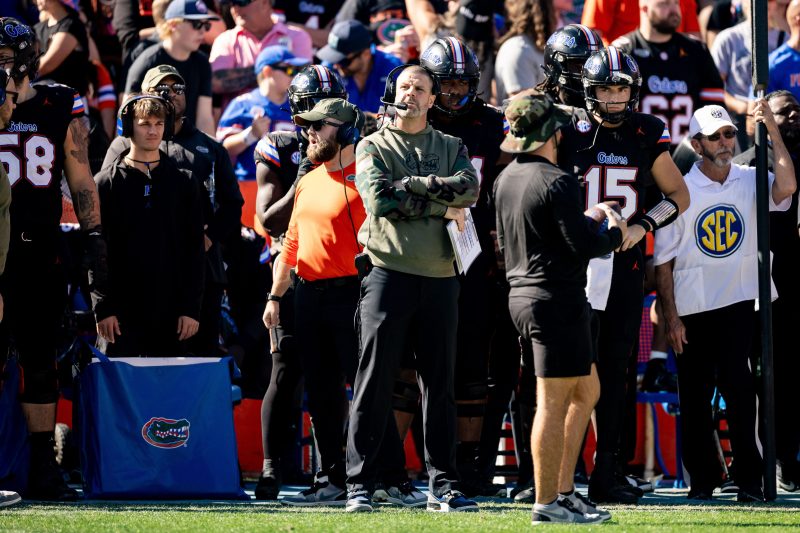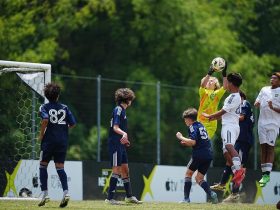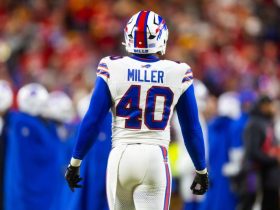To make sense of why Billy Napier seems to be flailing in his second year at Florida, we must revisit an incident from his time at Louisiana-Lafayette.
In 2019, Napier said scholarship players would be required to donate $50 to the athletic department’s fundraising arm, though later the school clarified that it was only encouraged. Napier defended it with a lot of platitudes, saying he wanted to build a culture of gratitude for all the work that went into making the players’ jobs easier.
That’s a nice idea, but the mechanism was all wrong. At a time when we should have been talking about schools paying players, the idea of players paying the school was a failure to read the room.
Why is that relevant to Florida? It’s a question of style over substance. Napier is a genial person, but he’s the king of coach speak. He loves quoting famous people. He loves a buzzword as much as a first down. He says what he thinks you want to hear.
And that’s a great way to get a big-boy job like Florida. It’s not necessarily a great way to keep it, especially at a school that chewed through three coaches in 11 seasons before Napier showed up.
Last year, Napier lost a lot of credibility with the Florida fan base when he ended his debut season with consecutive losses to Vanderbilt, Florida State and Oregon State to finish 6-7. But there was promise in the offseason of improvement, excitement about new facilities and a recruiting uptick — a real chance for Napier to get some momentum and have the fan base fully behind him.
Instead, what happened? Florida looked awful in the season opener at Utah, but seemed to recover in September by notching a good win over Tennessee. Then the Gators got stomped 33-14 at Kentucky, weren’t even remotely competitive with Georgia and have now suffered a true humiliation with Saturday’s 39-36 overtime loss to Arkansas in the Swamp.
HIGHS AND LOWS: Winners and losers from Week 10 in college football
MAKING MONEY: Florida win adds millions to Arkansas coach buyout
What’s Florida’s identity? What are the Gators actually good at? And why is Napier clinging to his offensive play-calling duties when the offense hasn’t been very effective?
These are all questions that Florida fans are asking, and rightfully so. As Georgia has become the nation’s dominant program and Florida State has ascended to a College Football Playoff caliber outfit, Napier hasn’t shown that he’s the game-changer to get Florida back on that level.
Just like at Louisiana-Lafayette, he’s very good at projecting his values and that he’s about the right things. But that only matters if it translates to the football field, and so far it isn’t at Florida.
The stakes here are very high. Napier has a massive contract and a buyout that would edge toward $32 million after this season. Also, if Napier fails, that would make athletics director Scott Stricklin 0-for-2 in football hires — and these days you don’t normally get three bites at that apple.
Can Florida stomach one more year of this just to see if there’s any possibility of this working, or is the anger going to be so intense that it’s time for yet another change in Gainesville? When you lose to Arkansas, it’s time to start asking those questions. That’s why Florida is No. 1 in the Misery Index, a weekly measurement of which fan bases are feeling the most angst.
Four more in misery
Syracuse
Dino Babers spent the first 24 years of his career bouncing around 10 different schools as an assistant without getting much of a look to be a head coach. Then, almost out of nowhere, he got three head coaching jobs in the span of five years and ended up landing the big payday at Syracuse. That dramatic change in trajectory happened largely because Babers was at Baylor for the beginning of the Art Briles era, a time when every moribund program in college football wanted to replicate that offense.
There have been flashes of the high-octane, early 2010s Baylor offense at Syracuse under Babers, but it hasn’t been consistent. And now it’s nowhere to be found. Syracuse fell to 0-5 in the ACC (4-5 overall) after a 17-10 loss at home to Boston College. The Orange has scored 44 points in those conference losses — not an average, but a raw total over five games.
Despite some good moments and one excellent season in 2018, Syracuse is on track for a sixth losing season in eight years under Babers. It’s probably time for a change.
Wisconsin
When Paul Chryst was fired in the middle of last season, it seemed strange from the outside. Though there had been some minor slippage from 2020 onward, Chryst’s overall track record was very good. What Wisconsin’s administration saw, however, was a program rotting from the inside and in need of drastic change. They were correct.
The problem is that Wisconsin’s poor performance this season goes on Luke Fickell’s record, and thus Fickell is the guy that many Badger fans are blaming for a 5-4 record that now includes a 20-14 loss at Indiana. Is that fair? We won’t know for a couple years whether Fickell can win in the Big Ten, but he’s not a miracle worker. When he got to Cincinnati, it took suffering through a 4-8 season to clean up Tommy Tuberville’s mess before the winning started in Year 2. At Wisconsin, it may not even happen that fast.
If there is one reason to be legitimately concerned, it’s the lack of offensive production. In losses to Iowa, Ohio State and now Indiana, Wisconsin has averaged just 10 points. Fickell hired Phil Longo, a denizen of the Air Raid coaching tree, to handle that side of the ball. So far, there has hasn’t been much Airing or Raiding in Madison.
Oklahoma
There’s a simple rule in football. When you’re trailing at the end of a game and must convert a fourth down to keep hope alive, throw the ball past the first-down marker. For some reason, Oklahoma did not do that in a 27-24 loss to Oklahoma State. In other words, the Sooners’ final play of a Bedlam rivalry they’ve mostly dominated since 1904 will forever be Dillon Gabriel throwing to Drake Stoops for three yards when they needed five.
Oklahoma fans don’t have a ton to complain about in Bedlam — they lead the overall series 91-20-7 — but it definitely leaves a sour taste to end things with a 27-24 loss in their final trip to Stillwater before heading to the SEC. It’s also the loss that knocks the 7-2 Sooners out of College Football Playoff consideration, and at the end they had to hear Taylor Swift’s “We Are Never Ever Getting Back Together” blaring over the loudspeakers. That’s a rough way to close out this rivalry and also a pretty humbling way to show the country that you’re not ready for prime time. The Sooners are a limited team that had a ton of roster turnover in Brent Venables’ second year but played above their heads to reach 7-0. Now after consecutive road losses to Kansas and Oklahoma State, it’s clear Venables has a lot more work to do.
San Diego State
Spare some pity for any Aztec fan in your life. Just five months ago, this school was so certain a Pac-12 invitation was on the way that it notified the Mountain West it intended to leave the conference and wanted to start working on exit terms. But the invitation never came, the Pac-12 imploded and San Diego State had to come back hat-in-hand to make amends with the only viable conference where it fit. Then football season started, and somehow things got even worse. San Diego State has been blown out, shut out (by 2-7 Nevada of all teams) and now clipped in double overtime by Utah State, 32-24. All told, that’s six losses in the Aztecs’ last seven games to sink to the bottom of the league they were supposed to be leaving. And considering San Diego State hasn’t had a losing season since 2009, that’s a pretty unacceptable string of performances under Brady Hoke. Just two years ago, Hoke led San Diego State to a 12-2 season in his second go-round with the Aztecs (he also coached them in 2009 and 2010 before getting the Michigan job). But for a program with the aspirations and resources to win big in the Mountain West and to eventually upgrade leagues, you can’t let things slip this dramatically and this quickly.
Miserable but not miserable enough
Miami (Fla.)
Here at the Misery Index, we have spent a lot of time chronicling Mario Cristobal’s struggles with game day decision-making and clock management. We haven’t talked enough about how badly they’re still underperforming in Cristobal’s second year. The Canes’ 20-6 loss at North Carolina State — and not one of the better NC State teams of recent vintage, by the way — is an eyebrow raiser. If you take out the fluke loss to Georgia Tech where Cristobal mangled the end-of-game clock situation, Miami fans could have squinted hard and figured out a way to call this season a success. But at 6-3, with Florida State and Louisville next up, how much progress has actually been made from last year when they went 5-7? Even if some reasonable Miami fans knew this would be a long process, there was at least hope in quarterback Tyler Van Dyke playing like the first-round NFL draft prospect some people consider him to be. Instead, he’s thrown 10 interceptions over his last four games.
Cincinnati
As mentioned above, Wisconsin fans are not particularly happy right now with Fickell. But the school on the other end of that transaction has it even worse. After Fickell led Cincinnati to the College Football Playoff just a couple years ago out of the American Athletic Conference, the Bearcats’ transition to the Big 12 has been a disaster. Scott Satterfield, who left Louisville to take this job, officially coaches the worst team in the conference after a 28-26 loss to Central Florida. Cincinnati, a program that has been consistently good for 20 years, is now 2-7 overall and 0-6 in its new league. Did Fickell leave a broken program behind? Is Satterfield just doing a terrible job? Will things get better next year? A Cincinnati fan can’t be certain about any of those answers at this point.
Mississippi State
It’s difficult to talk about what’s happening here without acknowledging the terrible blow Mississippi State absorbed last December when Mike Leach passed away. Programs are built around the specific qualities of their head coach, and Leach was such a unique figure in both his personality and approach to football that any change was going to be noticeable. The hope in Starkville was that 37-year old Zach Arnett, who was Leach’s excellent defensive coordinator, would be able to keep things going. But Year 1 has been frustrating for Bulldog fans, who have watched their team struggle to score (averaging 14 points in SEC play) and record just one conference win (a 7-3 barnburner over Arkansas). It doesn’t help that quarterback Will Rogers has been injured since early October and may not come back this year. Still, this season has gone poorly enough that the school’s administration will have to at least think about a coaching pivot given that they could buy Arnett out for a relatively cheap $4.5 million.
Kent State
There’s a certain level of humiliation that surrounds a program when its head coach leaves voluntarily to be an assistant somewhere else. But that’s also a very real part of life in the MAC, where only two head coaches make more than $1 million annually and it’s difficult to distinguish yourself enough for career advancement. So after five hard but pretty successful years relative to the program’s history, Sean Lewis left to be Deion Sanders’ offensive coordinator at Colorado. This week, Lewis was essentially demoted and stripped of play calling duties even though offense wasn’t the Buffaloes’ biggest problem. Meanwhile, the program he left behind is now 1-8 after a 31-27 loss to fellow MAC bottom-feeder Akron. The positive spin is it was Kent State’s closest loss this season after getting blown out by at least two touchdowns in every other game. But it goes to show you just how difficult a job it is that things could spiral so quickly after Lewis, who went 18-10 in the MAC over his last four seasons.






